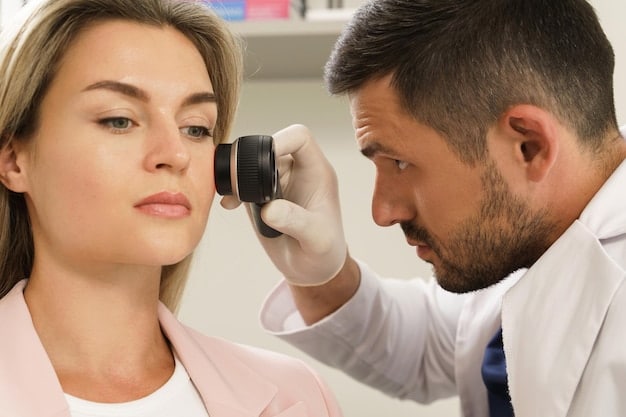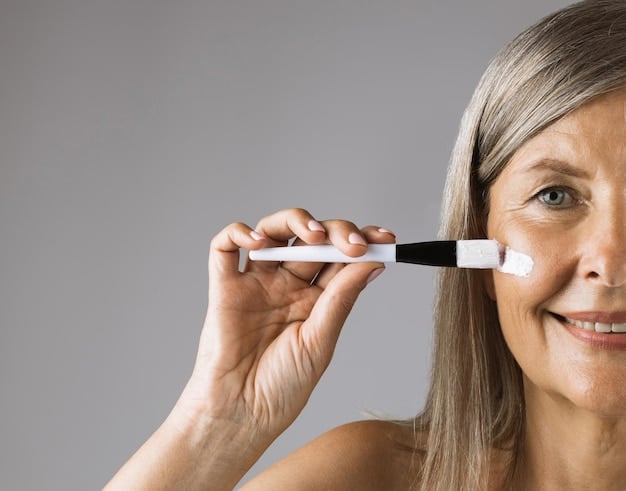Banish Under-Eye Circles: Effective Treatments for 2025

Banish Under-Eye Circles: A Comprehensive Look at Effective Treatment Options for 2025 explores the various factors causing under-eye circles and provides an in-depth analysis of innovative and proven treatments, lifestyle adjustments, and preventative measures for achieving a refreshed and youthful appearance.
Tired of those persistent shadows under your eyes? Banish Under-Eye Circles: A Comprehensive Look at Effective Treatment Options for 2025 offers a roadmap to a brighter, more youthful appearance, exploring the latest and most effective strategies to combat dark circles.
Understanding the Causes of Under-Eye Circles
Under-eye circles, those dark shades beneath your lower eyelids, can give the impression of fatigue or aging. Understanding the root causes is the first step to effective treatment. Several factors contribute to their formation.
Genetic Predisposition
Genetics play a significant role. If your parents or grandparents had prominent under-eye circles, you’re more likely to develop them as well. This predisposition can affect skin thickness and pigmentation in the under-eye area.
Aging Process
As we age, the skin under our eyes becomes thinner, making blood vessels more visible. Collagen and elastin, which provide support and elasticity to the skin, decrease over time, leading to increased translucency and the appearance of dark circles.

Lifestyle Factors
Certain lifestyle choices can exacerbate under-eye circles. Lack of sleep, dehydration, and poor diet can all contribute to their appearance. Excessive sun exposure can also increase pigmentation in the under-eye area.
- Sleep deprivation: Insufficient rest can cause blood vessels to dilate, leading to darker under-eye circles.
- Dehydration: Lack of adequate water intake can make the skin appear dull and sunken, emphasizing the appearance of dark circles.
- Poor diet: Diets lacking essential vitamins and minerals can affect skin health and contribute to under-eye darkness.
Understanding these factors is crucial for tailoring effective treatment strategies to address the specific causes of your under-eye circles. With the right approach, you can significantly reduce their appearance and achieve a more refreshed look.
Topical Treatments for Under-Eye Circles
Topical treatments are a popular and accessible option for addressing under-eye circles. These products contain ingredients that target specific issues like pigmentation, blood vessel visibility, and skin hydration. Regularly applying these treatments can lead to visible improvements.
Retinoids
Retinoids, derived from vitamin A, stimulate collagen production and increase cell turnover. This helps to thicken the skin under the eyes, making blood vessels less visible. Retinoids can also reduce hyperpigmentation, further diminishing the appearance of dark circles.
Vitamin C Serums
Vitamin C is a potent antioxidant that protects the skin from free radical damage and promotes collagen synthesis. It can also brighten the skin and reduce the appearance of dark circles caused by pigmentation. Look for stable forms of vitamin C, such as L-ascorbic acid, for maximum effectiveness.

Hyaluronic Acid Creams
Hyaluronic acid is a humectant that attracts and retains moisture in the skin. By hydrating the under-eye area, hyaluronic acid can plump the skin and reduce the appearance of fine lines and dark circles caused by volume loss. It’s particularly beneficial for those with dry or dehydrated skin.
- Consider combining retinoids with hyaluronic acid to mitigate potential irritation.
- Apply topical treatments consistently as directed for optimal results.
- Protect the under-eye area with sunscreen during the day to prevent hyperpigmentation.
Topical treatments offer a non-invasive way to target the underlying causes of under-eye circles. By incorporating these products into your skincare routine, you can achieve a brighter, more youthful appearance.
Professional Treatments for Under-Eye Circles
When topical treatments aren’t enough, professional procedures offer more intensive solutions for under-eye circles. These treatments, performed by dermatologists or cosmetic surgeons, can provide significant and long-lasting results. However, they typically involve higher costs and potential risks.
Laser Therapy
Laser treatments can target various causes of under-eye circles. Vascular lasers reduce the appearance of visible blood vessels, while pigment lasers target hyperpigmentation. Fractional lasers stimulate collagen production and improve skin texture.
Chemical Peels
Chemical peels involve applying a chemical solution to the skin to exfoliate the outer layers. This process can reduce pigmentation, improve skin texture, and stimulate collagen production. Superficial to medium-depth peels are commonly used for under-eye circles.
Dermal Fillers
Dermal fillers, typically made of hyaluronic acid, can be injected into the under-eye area to restore lost volume and smooth out hollows that contribute to dark circles. Fillers provide immediate results and can last from six months to a year.
- Research qualified and experienced practitioners before undergoing any professional treatment.
- Discuss potential risks, benefits, and costs with your provider.
- Follow aftercare instructions carefully to minimize complications and optimize results.
Professional treatments offer targeted solutions for addressing persistent under-eye circles. With careful planning and expert execution, these procedures can deliver remarkable improvements in your appearance.
Lifestyle Adjustments to Minimize Under-Eye Circles
In addition to topical and professional treatments, lifestyle adjustments can play a crucial role in minimizing under-eye circles. Small changes to your daily habits can significantly impact the appearance of your under-eye area. Prioritizing self-care and healthy practices is key.
Adequate Sleep
Aim for 7-8 hours of quality sleep each night. Sleep deprivation can cause blood vessels to dilate and make under-eye circles more pronounced. Establish a consistent sleep schedule and create a relaxing bedtime routine to promote better sleep.
Proper Hydration
Drink plenty of water throughout the day to keep your skin hydrated and plump. Dehydration can make the skin appear dull and sunken, emphasizing the appearance of dark circles. Aim for at least eight glasses of water daily.
Healthy Diet
Consume a balanced diet rich in fruits, vegetables, and lean protein. Essential vitamins and minerals support skin health and can help reduce inflammation and pigmentation. Limit processed foods, sugary drinks, and excessive salt intake.
- Elevate your head while sleeping to reduce fluid retention around the eyes.
- Reduce alcohol and caffeine consumption, as they can dehydrate the skin.
- Manage stress through relaxation techniques like yoga or meditation.
Lifestyle adjustments are a simple and effective way to support your skincare efforts and minimize under-eye circles. By incorporating these healthy habits into your routine, you can achieve a brighter, more refreshed appearance.
Home Remedies for Under-Eye Circles
For a natural approach to reducing under-eye circles, home remedies offer simple and affordable solutions. While they may not provide as dramatic results as professional treatments, they can help improve the appearance of the under-eye area with consistent use.
Cold Compresses
Applying cold compresses to the under-eye area can constrict blood vessels and reduce swelling. Soak a clean cloth in cold water and apply it to your eyes for 10-15 minutes. Repeat several times a day for best results.
Tea Bags
Caffeinated tea bags contain antioxidants and tannins that can help constrict blood vessels and reduce inflammation. Steep two tea bags in hot water for 3-5 minutes, then chill them in the refrigerator. Apply the cooled tea bags to your eyes for 15-20 minutes.
Cucumber Slices
Cucumber slices have cooling and anti-inflammatory properties that can help soothe and hydrate the under-eye area. Place chilled cucumber slices on your eyes for 15-20 minutes to reduce swelling and dark circles.
- Gently massage the under-eye area to improve circulation.
- Use arnica cream to reduce bruising and inflammation.
- Try a DIY mask with ingredients like honey and aloe vera for added hydration.
Home remedies offer a gentle and natural way to address under-eye circles. Incorporating these remedies into your routine can complement other treatments and help you achieve a brighter, more refreshed appearance.
Preventative Measures for Under-Eye Circles
Preventing under-eye circles is often easier than treating them. By adopting proactive measures, you can minimize their appearance and maintain a youthful, refreshed look. Protecting your skin and making healthy choices are essential.
Sun Protection
Apply a broad-spectrum sunscreen with an SPF of 30 or higher to the under-eye area every day, even on cloudy days. Sun exposure can increase pigmentation and worsen dark circles. Wear sunglasses to shield your eyes from harmful UV rays.
Gentle Skincare
Use gentle skincare products specifically formulated for the delicate under-eye area. Avoid harsh scrubs, exfoliants, and ingredients that can irritate the skin. Gently pat on products instead of rubbing to minimize damage.
Allergy Management
Control allergies to prevent inflammation and swelling around the eyes. Allergies can trigger histamine release, which can lead to dilated blood vessels and darker under-eye circles. Consult with an allergist for appropriate treatment options.
- Remove makeup thoroughly before bed to prevent irritation and clogged pores.
- Avoid rubbing your eyes, as this can damage delicate blood vessels.
- Stay consistent with your skincare routine for long-term benefits.
Preventative measures are essential for maintaining a bright and youthful under-eye area. By protecting your skin and making healthy choices, you can minimize the appearance of dark circles and preserve your natural radiance.
| Key Point | Brief Description |
|---|---|
| 😴 Adequate Sleep | Aim for 7-8 hours of quality sleep to reduce blood vessel dilation. |
| 💧 Proper Hydration | Drink plenty of water to keep skin hydrated and plump. |
| 🛡️ Sun Protection | Use sunscreen daily to prevent hyperpigmentation. |
| 🌿 Topical Treatments | Use retinoids and Vitamin C serums for brighter skin. |
FAQ
▼
Under-eye circles can stem from genetics, aging (thinning skin), lifestyle factors like sleep deprivation, dehydration, and hyperpigmentation due to sun exposure or skin conditions.
▼
Effective topical options include retinoids (for collagen production), vitamin C serums (for brightening), and hyaluronic acid creams (for hydration). Consistency is key for visible improvements.
▼
Professional options are laser therapy, chemical peels, and dermal fillers. Consult with a cosmetic surgeon for the best tailored approach.
▼
Yes, sufficient sleep, proper hydration, and a healthy diet can greatly minimize the appearance. Elevating your head may also help reduce fluid retention.
▼
Cold compress, tea bags, and cucumber slices are great remedies to reduce swelling. Gentle massage helps in improving circulation and the appearance of circles.
Conclusion
Addressing under-eye circles requires a multifaceted approach, combining lifestyle adjustments, topical treatments, and, in some cases, professional procedures. Understanding the underlying causes and consistently implementing preventative measures will ultimately help you achieve a brighter, more refreshed appearance in 2025 and beyond.





